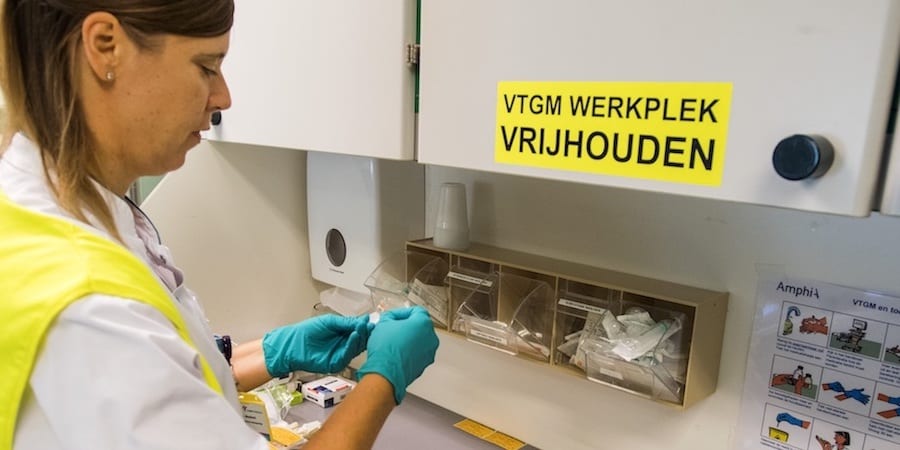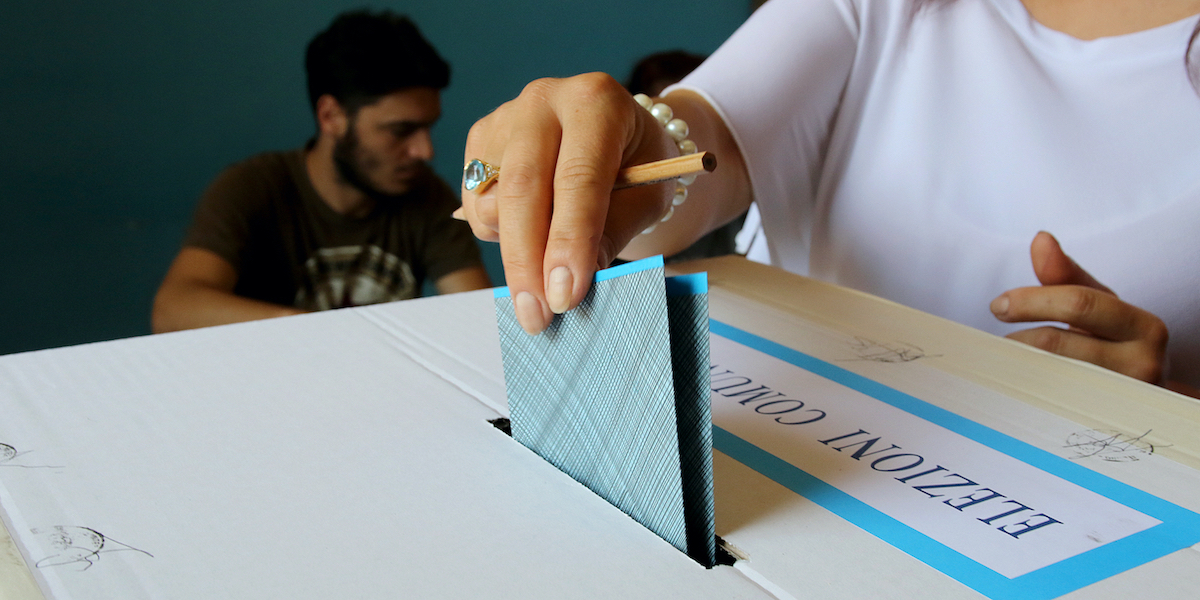
How this hospital made nurses its key lean change agents
INTERVIEW – Bringing nurses together and giving them a space to discuss problems on a regular basis has allowed this hospital in Holland to successfully embrace lean thinking and reap its benefits.
Interviewees: Christiaan Hol, Process Improvement and Innovation, and Simone Voets, team leader in Neurology Department, Amphia Hospital – Breda, Netherlands
Main picture by: Beeld Werkt
Planet Lean: Can you provide us with some context about your hospital, please?
Christiaan Hol: Amphia is a large teaching hospital in Breda, in the south of Holland. We treat 172,000 unique patients each year and receive 620,000 outpatients visits annually. We employ 4,400 people (of which around 1,500 are nurses) and have 350 volunteers. There are 270 medical specialist (from Medisch Specialistisch Bedrijf, which translates into Medical specialists corporation) working at Amphia.
PL: What led you to the adoption of lean thinking at Amphia?
CH: A perfect storm, I would say. There was an external push coming from the government, with an inspection highlighting some areas that needed improvement, a managerial push to go for the JCI accreditation, and of course the every-day problems we encountered and that needed solving. We don’t see lean as the goal, but as a means to getting where we want to be.
Simone Voets: We have been discussing how to bring change to our hospital for years. We first experimented with lean around seven years ago. In an initial attempt to improve our work, we turned to the Productive Ward approach. We then worked with nurses to identify the problems preventing from doing their job properly and solve them. Unfortunately, none of those efforts led to an Amphia-wide implementation. It’s the combination of factors Christiaan mentioned that eventually allowed lean to stick.
PL: One of the main problems you faced was in the preparation of drugs, right?
SV: Indeed. We had an area dedicated to this important activity, but it wasn’t up to scratch and there were a number of protocols that were difficult to follow due to the constraints of the space we worked in. We had to change the process, reorganize the wards (after a spaghetti diagram showed how much we were moving), and train staff in the new system.
CH: Safety is the main concern with drug preparation, and there are several sides to it: getting the right drug to the right patient, avoiding contamination, and creating a safe environment for our workers. We had to build separate rooms to avoid people being disturbed while they prepared the medication: among other things, we now use a scan that matches each patient with the drugs they need.
PL: How did you engage your 1,500 nurses in the improvements you wanted to bring to the hospital?
CH: We try to get our nurses to act as a united front, giving them an official voice in the organization. Before lean was adopted, nursing team leaders mainly focused on deciding the working schedule, whereas now they actively participate in the achievement of organizational goals. To empower them to do this, we arranged leadership coaching that provided nurses with a number of lean skills. (For instance, we taught them about stand-up meetings and visual management boards.) More importantly, we gave them the opportunity to come together and share problems, knowledge and ideas on a regular basis. Currently, nursing team leaders from different wards meet once a month during the “team leader council”. This meeting, which is organized and facilitated by Chief Nurse Ellen Verheesen (pictured on the right, in a photo by Beeld Werkt), has become the cornerstone of our lean journey.
SV: The problems different wards face are often the same and it is invaluable to have others who have gone through the same tell you about their experience.These meetings are very beneficial, bringing consistency in the way we do things across the organization. Decisions are made and solutions evaluated together, so that changing direction is possible whenever necessary.
But it wasn’t always easy. At first, when we asked nurses to develop a consistent way of working, they told us they couldn’t because every ward is different.After meeting a few times, however, they realized they often had the same problems and that, therefore, they could have the same processes too.
PL: How did you go about transforming the process in the hospital?
SV: Patients who are admitted in the wards come from two main streams – emergency and outpatient. For each of them, we identified four main “stages” in the process (registration, admission, treatment, and discharge) and dived into each of those. We asked every team leader to write down, within a template, a step-by-step description of what they do for each of the stages in the process. Together, we then devised a standard process and set up a few pilot projects and experiments to test its effectiveness.
CH: We also looked at the JCI requirements for each of the steps in the newly-designed process, and we tried to understand how EPIC, our IT system, could best support them. And then we started to improve. The game-changer for us was to bring people together to create a standard, because, as difficult as it was at the beginning, having to come up with a common process is what is ultimately changing our culture.
PL: Can you give us any examples of improvements?
CH: One of the problems that the team leaders identified was that there were different processes in place in different departments with regards to purchasing, maintenance, storage and use of materials. So, we created a standard method for each of these activities, which is now used across the hospital. Where necessary, things are first tested in a pilot department led by one of the team leaders.
Another improvement was carried out by our facility management department. Each ward used to have its own stash of materials, and they were hiding it from others, because they were always afraid they’d run out. After we realized how much time people were spending just looking for things, we moved all those materials to a central location. This way, the wards are clear of materials, there is less stock, but everything that is necessary is readily available. The service supplying materials to the different areas is fast and reliable. We use the same idea for our new system for moving patients: whereas in the past we had to wait up to an hour for a porter to show up, now the one closest to the ward in need of a transfer typically shows up in minutes.
Another improvement we are now preparing for the new building we are constructing is in the distribution of drugs, which will soon be carried out using two robots – one will take pills out of the package, while the other will dispense them on trays based on the needs of each patient. This way, human error will be eliminated and the pharmacy will operate 24/7, even after the pharmacists will have gone home for the day. The delivery system for medicines will work in conjunction with the automated pharmacy: a pneumatic tube transport system will deliver drugs to the ward each patient is in.
All these improvements were co-created and implemented with our Team Leaders Council.
PL: We understand you had an interesting experience with the new medicine carts you bought. Can you tell us about it?
SV: Our old carts were falling apart, and had just become obsolete. When we designed the new process (also with an eye at the new hospital wing we are building next to our current facility), we decided to buy new carts that could work in both the current and the future locations. Based on a set of criteria we identified as fundamental, we picked a cart model that we thought could work. When we asked nurses to check it out and give us feedback, they said they didn’t like it and that we shouldn’t order it. It quickly became clear, however, that it was the only model that could work in the new process, and we decided to buy it despite the negative feedback we had received. Understandably, we got a lot of pushback, because we hadn’t listened to people enough. We realized we had to do it better, and that’s when we got a multi-functional team involved. This team was led by one of the team leaders from the Team Leaders Council. They understood the need for that specific cart, and help us get the rest of the nurses on board.
PL: Another example of how bringing people together helps them see the big picture…
SV: Exactly. When you struggle with something and you know another ward has succeeded at it, you can ask them for help. Nurses, and not just team leaders, are taking more responsibility in solving problems now – I think because they have a system to solve problems and because they know they can get support if they need it. In general, people are more aware of their jobs, and other people’s.
PL: How do you ensure knowledge-sharing across the organization?
SV: New standards and ways of working are tested by our nurses in the pilot department. From there, a best practice is defined and together with all team leaders an implementation plan is put together, which is then carried out in each department by the team leaders on their own wards.
PL: What is your role in the transformation, as leaders?
CH: We just provided people with the initial help they needed, and we then encouraged them to start owning problems and become increasingly autonomous in solving them. As facilitators, we don’t tell them what to do, but listen to their problems at the gemba. It’s a fundamental shift that needs to happen in an organization that embraces lean thinking.
PL: What direct benefits of the lean transformation have patients already started to notice?
SV: First and foremost, their experience while at Amphia. Patients get a lot of direct attention from us these days. It is clear how much they appreciate our nurses not simply giving them drugs, but also taking the time to explain what those drugs are for. The fact that two nurses double-check medication at the bedside, the fact that we scan barcodes for patient identification, and the fact that we share more information with patients than ever before all contribute to making them feel safer. And what’s more important in a hospital than to feel safe?
THE INTERVIEWEES


Read more


FEATURE – Based on her experience at Lean Institute Colombia, the author lists five common mistakes hindering a lean transformation. Take note!


FEATURE – To get the results we want from a system, or prevent it from generating undesirable events, we need to understand how it works and behaves in the real world. That’s exactly what Jidoka does.


INTERVIEW – Toyota’s approach to developing capabilities and its focus on life-long learning are inspirational. But how do people at Toyota actually learn?


CASE STUDY – Have you ever considered how Lean Thinking could apply to politics? The author explains how the result of a mayoral race in southern Italy was ultimately determined by the lean approach adopted by one of the candidates.

